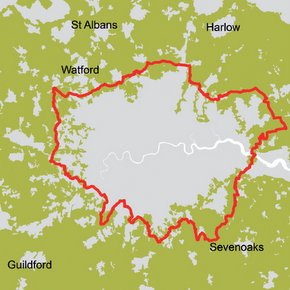
New villages and housing to be built on London’s Green Belt
Howard Chapman takes a look at the new LSE proposals for the expansion of London’s housing supply via the strategic use of the Metropolitan Green Belt.
The Metropolitan Green Belt around London was originally proposed in the late nineteenth century; it was first realised in the 1930s, and expanded under Abercrombie’s 1944 Greater London Plan. After decades of growth, the Green Belt now measures 5,160 square kilometres and covers parts of 68 local districts and London boroughs.
The current aims of the Green Belt policy are set out in the National Planning Policy Framework (NPPF), which states that the policy’s fundamental objective is to prevent urban sprawl by keeping land permanently open. The government guidance also suggests that local authority might want to utilise Green Belt to improve public access, provide recreation opportunities or improve the appearance or quality of the land.
A 21st Century Metropolitan Green Belt
A new report from the London School of Economics (LSE), entitled A 21st Century Metropolitan Green Belt, calls for the careful and strategic development of the Green Belt in and around London, to help deliver the new homes needed for the city’s expanding population.

Read the report here
This would help to create new metropolitan villages, within 2 miles of existing transport links, whilst making effective use of the ‘corridors’ of Green Belt land, adjacent to major roads, such as the M11 between London and Cambridge.
These new housing developments would not be added in ‘piecemeal’ encroachments onto Green Belt; they would be part of a new planned approach to building on protected land to create a bigger city, complete with ‘wedges’ of accessible, high quality green space.
‘We have reached a point where we cannot keep on disregarding the Green Belt as an option for well thought out development,’ comments Alan Mace, assistant professor of Urban Planning studies at LSE.
‘Brownfield sites cannot supply enough land to meet the projected housing needs in London and the wider south-east. People often look at the Green Belt and say, “who would want to lose this?” But they’re looking at land that is protected in other ways, such as metropolitan parks or areas of outstanding natural beauty, and this would not change.’
However, in initial response to the LSE’s proposal, the Campaign to Protect Rural England argued that said the priority should be Green Belt protection.
Paul Miner, the CPRE’s planning campaign manager, commented: ‘If we are to build the homes we need, we have to reinforce current protections and put Brownfield first, not weaken Green Belt policy on an agenda of economic growth in the south-east.’
Despite this, LSE firmly believes that housing should be strategically built on the Metropolitan Green Belt to halt its piecemeal development and alleviate development pressure on the wider South East, whilst protecting environmentally important areas.
Other useful reports on Green Belt:
- The Green Belt: A Place for Londoners?
- New London villages: Creating communities
- Accelerating Housing Production in London
- Housing in London: Addressing the Supply Crisis
Latest news

26th July 2024
Enfield Speciality Doors completes world-class project for Atlas Copco HQ
A rundown office and warehouse building completely transformed into a modern headquarters for Atlas Copco has been fitted with more than 120 internal fire doors from Enfield Speciality Doors.
Posted in Access Control & Door Entry Systems, Articles, Building Industry News, Building Products & Structures, Building Systems, Case Studies, Doors, Interior Design & Construction, Interiors, Posts, Restoration & Refurbishment, Retrofit & Renovation, Security and Fire Protection, Sustainability & Energy Efficiency, Timber Buildings and Timber Products, Wooden products
26th July 2024
Abloy UK launches new white paper
Abloy UK, a leading provider of security and access control solutions, has launched a new white paper.
Posted in Access Control & Door Entry Systems, Architectural Ironmongery, Articles, Building Industry News, Building Products & Structures, Building Services, Doors, Facility Management & Building Services, Health & Safety, Information Technology, Innovations & New Products, Publications, Research & Materials Testing, Security and Fire Protection
26th July 2024
MCRMA Member Profile: David Roy, Director of Roofconsult
David Roy of MCRMA member company Roofconsult has more than 50 years’ experience to draw upon working in the building envelope sector and a unique perspective on how it has changed in that time.
Posted in Articles, BIM, Infrastructure & CAD Software, Building Associations & Institutes, Building Industry News, Building Products & Structures, Building Services, Building Systems, Cladding, Information Technology, Restoration & Refurbishment, Retrofit & Renovation, Roofs, Walls
26th July 2024
Strand: Enhancing Door Functionality and Safety
Craig Fox, Sales Director for Strand Hardware, outlines how door industry professionals might apply door limiting stays…
Posted in Architectural Ironmongery, Articles, Building Industry News, Building Products & Structures, Building Services, Doors, Facility Management & Building Services, Health & Safety, Restoration & Refurbishment, Retrofit & Renovation
 Sign up:
Sign up: